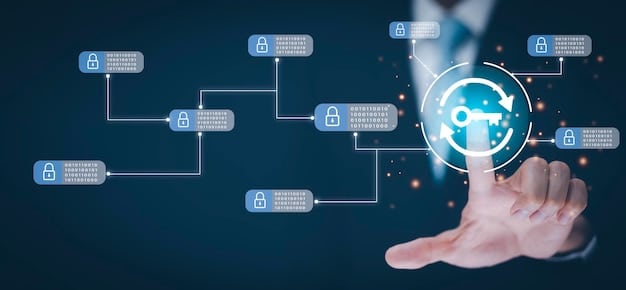Cybersecurity Legislation Impact on Small Businesses: A Practical Guide

The Impact of the Proposed Cybersecurity Legislation on Small Businesses: A Practical Guide outlines how new cybersecurity laws affect small business operations, compliance, and overall security posture, providing actionable insights for navigating these regulatory changes.
Navigating the complex landscape of cybersecurity legislation can be daunting for small businesses. This guide, The Impact of the Proposed Cybersecurity Legislation on Small Businesses: A Practical Guide, aims to simplify these challenges, offering actionable steps to ensure compliance and strengthen defenses.
Understanding the Evolving Cybersecurity Landscape
The digital age has brought immense opportunities for small businesses, but it has also exposed them to increasing cybersecurity threats. A clear understanding of the current regulations is the first barrier of defense for a business.
Cybersecurity legislation is constantly evolving to combat these threats and protect sensitive data. It is essential for small businesses to stay informed about these changes to avoid potential legal and financial repercussions.
Key Cybersecurity Laws Affecting Small Businesses
Several key laws have a direct impact on how small businesses handle cybersecurity. Familiarizing yourself with these is crucial for compliance.
- The Cybersecurity Information Sharing Act (CISA): Encourages information sharing about cyber threats between the government and private sector entities.
- The California Consumer Privacy Act (CCPA): Grants consumers more control over their personal information and imposes strict data privacy requirements.
- The Health Insurance Portability and Accountability Act (HIPAA): Protects sensitive patient health information from being disclosed without the patient’s consent or knowledge.

The Importance of Staying Updated
New cybersecurity threats emerge daily, and legislation is constantly being updated to address these evolving risks. Regularly reviewing and updating your cybersecurity policies and practices is vital.
Utilizing resources such as industry publications, government websites, and cybersecurity experts can help you stay informed about the latest changes. The goal is to have your security protocols constantly updated to protect against new threats.
In summary, understanding and staying ahead of the evolving cybersecurity landscape is paramount for small businesses. By being proactive and informed, you can minimize risks and ensure compliance.
Assessing Your Business’s Cybersecurity Needs
Before implementing any security measures, it’s crucial to assess your business’s specific cybersecurity needs. This evaluation will help you identify vulnerabilities and prioritize your security efforts.
Every business is unique, therefore the first step is to understand where the biggest risks for your particular business are.
Conducting a Risk Assessment
A risk assessment involves identifying potential threats, vulnerabilities, and the potential impact they could have on your business. This process provides a clear picture of your security posture.
Tools and frameworks like NIST Cybersecurity Framework and ISO 27001 can help you conduct a thorough risk assessment. These guidelines provide a structured approach to identifying and managing cybersecurity risks. They are also highly adaptable to any sort of business.
Identifying Vulnerabilities
Vulnerabilities are weaknesses in your systems that could be exploited by attackers. Common vulnerabilities include outdated software, weak passwords, and lack of employee training.
Regularly scanning your systems for vulnerabilities and addressing them promptly is essential. Penetration testing and vulnerability assessments can help identify these weaknesses. Consider hiring a cybersecurity company to scan for vulnerabilities and fix them.

Assessing your business’s cybersecurity needs is a critical step in protecting your assets and ensuring compliance. By understanding your risks and vulnerabilities, you can develop a targeted and effective security strategy.
Implementing Robust Security Measures
Once you’ve assessed your cybersecurity needs, it’s time to implement robust security measures. This involves establishing policies, investing in security technologies, and training staff.
By taking proactive measures that protect against both internal and external threats, the safety of your business can be strengthened.
Establishing Cybersecurity Policies and Procedures
Clear and comprehensive cybersecurity policies and procedures are essential for creating a security-conscious culture within your business.
These policies should cover topics such as password management, data handling, incident response, and acceptable use of technology. Ensure that all employees are familiar with these policies and understand their responsibilities.
Investing in Security Technologies
A range of security technologies can help protect your business from cyber threats. These include firewalls, antivirus software, intrusion detection systems, and data encryption tools.
- Firewalls: Act as a barrier between your network and the outside world, blocking unauthorized access.
- Antivirus Software: Detects and removes malicious software from your systems.
- Intrusion Detection Systems: Monitor network traffic for suspicious activity and alert administrators to potential threats.
Effective implementation of robust security measures significantly enhances your business’s protection against cyber threats. It is crucial to develop effective implementation strategies.
Employee Training and Awareness
Employees are often the first line of defense against cyber attacks. Comprehensive training and awareness programs are crucial for equipping your staff with the knowledge and skills they need to identify and respond to threats.
Many businesses overlook the human element of security. Ensuring that employees are well-informed is essential to creating a robust cybersecurity culture.
The Importance of Cybersecurity Awareness
Cybersecurity awareness training helps employees understand the risks they face and how to avoid becoming victims of cyber attacks. Many people can be tricked into exposing sensitive information.
Regular training sessions, phishing simulations, and awareness campaigns can help reinforce security best practices. Phishing simulations enable real-time feedback; this is one of the best ways to teach employees how to spot malicious emails.
Best Practices for Employee Training
Effective employee training should be engaging, relevant, and ongoing. It should also be tailored to the specific roles and responsibilities of your employees.
- Cover a Range of Topics: Including phishing, malware, password security, and data privacy.
- Use Real-World Examples: Demonstrate how cyber attacks can impact the business and its employees.
- Encourage Questions and Feedback: Create an open environment where employees feel comfortable asking questions and sharing concerns.
Establishing employee training and awareness programs is a critical investment in your business’s cybersecurity. By empowering employees to recognize and respond to threats, you can significantly reduce your risk of falling victim to cyber attacks.
Incident Response and Recovery Planning
Despite your best efforts, cyber incidents can still occur. Having a well-defined incident response and recovery plan is essential for minimizing the impact of an attack and restoring normal operations quickly.
Without a plan, confusion and delays can exacerbate the damage caused by a cyber incident.
Developing an Incident Response Plan
An incident response plan outlines the steps to take in the event of a cyber attack. It should include roles and responsibilities, communication protocols, and procedures for containing, eradicating, and recovering from the incident.
The plan should be regularly tested and updated to ensure its effectiveness. Conducting tabletop exercises and simulations can help identify gaps and improve the plan.
Data Backup and Recovery Strategies
Regularly backing up your business data is essential for ensuring that you can recover from a cyber attack or other disaster. Backups should be stored securely and tested regularly.
- Implement a Backup Schedule: Based on the frequency of data changes.
- Store Backups Offsite: To protect them from physical damage or theft.
- Test Your Recovery Procedures: To ensure that you can restore your data quickly and efficiently.
Effective incident response and recovery planning can significantly reduce the impact of cyber attacks on your business. It can also improve how you recover your important information.
Compliance and Legal Considerations
Navigating the legal and regulatory landscape of cybersecurity can be complex. Understanding your compliance obligations and ensuring that your security practices align with legal requirements is essential.
Compliance is not only a legal requirement but also a critical component of building trust with customers and partners.
Understanding Regulatory Requirements
Several laws and regulations, such as HIPAA, CCPA, and GDPR, impose specific cybersecurity requirements on businesses. It is essential to understand which regulations apply to your business and what steps you need to take to comply.
Staying informed about changes to these regulations and seeking legal advice when needed can help you avoid costly compliance violations. There are also consultants that businesses can hire.
Working with Legal Counsel
Engaging with legal counsel can provide valuable guidance on navigating cybersecurity laws and regulations. An attorney can help you assess your compliance obligations and ensure that your security practices align with legal requirements.
Legal counsel can also assist with drafting contracts, policies, and procedures that comply with applicable laws. Building a strong relationship with a lawyer can enable improved safety for a business.
Remaining compliant with laws can prevent incidents that would damage a business’s reputation and trustworthiness with customers and partners is crucial.
| Key Point | Brief Description |
|---|---|
| 🛡️ Understanding Laws | Staying updated on cybersecurity laws affecting your business. |
| 🔍 Risk Assessment | Identifying vulnerabilities and potential threats to your business. |
| 🧑💼 Training Staff | Educating employees to recognize and avoid cyber threats. |
| 🚨 Incident Response | Having a plan for how to respond to and recover from cyber incidents. |
Frequently Asked Questions (FAQ)
▼
CISA, the Cybersecurity Information Sharing Act, encourages businesses to share information about cyber threats with the government and each other. This helps create a more collaborative defense against cyber attacks.
▼
Cybersecurity policies should be reviewed and updated at least annually, or more frequently if there are significant changes to your business, technology, or the threat landscape. This ensures policies remain effective.
▼
Key elements include defining roles and responsibilities, establishing communication protocols, outlining procedures for containment and eradication, and detailing recovery strategies. Regular testing ensures the plan’s effectiveness.
▼
Employees are often the first line of defense against cyber threats. Training them to recognize phishing attempts, secure passwords, and follow data protection policies significantly reduces the risk of successful attacks.
▼
A risk assessment should identify potential threats, assess vulnerabilities in your systems, and evaluate the potential impact of a successful attack on your business operations. Scoping, measuring, and fixing are crucial as well.
Conclusion
In conclusion, navigating the impact of cybersecurity legislation requires a proactive and comprehensive approach. By understanding the evolving landscape, assessing your business’s needs, implementing robust security measures, training employees, and planning for incident response, small businesses can effectively protect themselves from cyber threats and ensure compliance with legal requirements.





